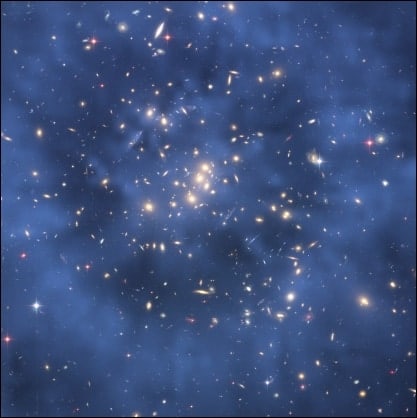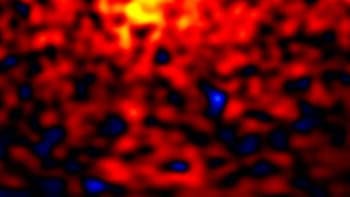A ring-shaped distribution of mass in a galaxy cluster five billion light-years from Earth is the strongest evidence yet for the existence of dark matter. This is the claim of physicists from the US and Europe, who have used data from NASA's Hubble Space Telescope to see how gravity is bending the light around the cluster. Unlike previous searches in other galaxy clusters, this would be the first time dark matter has been seen isolated in its own separate structure (arXiv.org/abs/astro-ph/0705.2171).

matter?
Dark matter is thought to constitute up to 95% of all matter in the universe. Although it has never been observed directly, most physicists believe it to exist because galaxies appear to rotate faster than they would if they only contained ordinary “baryonic matter”. The extra pull of the dark matter would explain away the unusual motion.
Unfortunately, it is difficult to prove dark matter exists because it is usually so mixed up with the baryonic matter that the two become indistinguishable. The two types of matter do sometimes become separated, however, during a collision between two galaxy clusters. Last year, for example, an analysis of the two colliding galaxy clusters known collectively as the “Bullet Cluster” seemed to identify to a dark matter distribution that was offset from the surrounding hot plasma – but the dark matter was still overlapping the galaxy clusters themselves (see related story: “Gravity lens reveals dark matter”).
Now a team led by James Jee of John Hopkins University in the US has found a dark matter distribution that they say is completely isolated from the baryonic matter. “In our case, the structure is different not only from the gas, but also from the galaxies,” Jee told Physics Web. “In other words, this is the first time that dark matter has been detected in its own structure.”
Jee’s team made the discovery while analysing Hubble telescope data of how light has travelled through of the galaxy cluster CL0024+17. Over long distances, large masses such as stars inside galaxy clusters can gravitationally bend passing light in a similar way to an optical lens. By using this “gravitational lensing” technique to map the distribution of mass in the cluster, the team were surprised to find that it implied there was a detached ring-shaped structure. “I have looked at a number of clusters, and I haven’t seen anything like this,” said Jee.
Dark matter may not be the only explanation for the findings, however. After dark matter was purportedly found in the Bullet Cluster last year, some physicists insisted the data could also be explained with alternative theories of gravity, such as modified Newtonian dynamics (MOND), which suggest that the familiar inverse-square law for gravity does not hold on cosmological scales. “It is always possible to tweak or introduce new parameters to physics in order to explain observations,” Jee continued. “However, it will certainly be harder for MOND people to explain our observation than the Bullet Cluster result because the dark matter structure is traced neither by the galaxies nor by the gas.”



